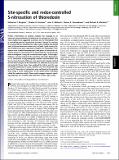Site-specific and redox-controlled S-nitrosation of thioredoxin
Author(s)
Barglow, Katherine T.; Knutson, Charles G. F.; Wishnok, John S.; Tannenbaum, Steven Robert; Marletta, Michael A.
DownloadTannenbaum-2011-Aug-Site-Specific and Redox.pdf (1.678Mb)
PUBLISHER_POLICY
Publisher Policy
Article is made available in accordance with the publisher's policy and may be subject to US copyright law. Please refer to the publisher's site for terms of use.
Terms of use
Metadata
Show full item recordAbstract
Protein S-nitrosation on cysteine residues has emerged as an important posttranslational modification in mammalian cells. Previous studies have suggested a primary role for thioredoxin (Trx) in controlling protein S-nitrosation reactions. Human Trx contains five conserved Cys, including two redox-active catalytic Cys (Cys32 and Cys35) and three non-active-site Cys (Cys62, Cys69, and Cys73), all of which have been reported as targets of S-nitrosation. Prior reports have studied thermodynamic end points of nitrosation reactions; however, the kinetics of Trx nitrosation has not previously been investigated. Using the transnitrosation agent, S-nitrosoglutathione, a kinetic analysis of the selectivity and redox dependence of Trx nitrosation at physiologically relevant concentrations and times was performed, utilizing a mass spectrometry-based method for the direct analysis of the nitrosated Trx. Reduced Trx (rTrx) was nitrosated 2.7-times faster than oxidized Trx (oTrx), and rTrx was nitrosated selectively on Cys62, whereas oTrx was nitrosated only on Cys73. These sites of nitrosation were confirmed at the peptide level using a novel modification of the biotin-switch technique called the reductive switch. These results suggest separate signaling pathways for Trx-SNO under different cellular redox states.
Date issued
2011-08Department
Massachusetts Institute of Technology. Department of Biological EngineeringJournal
Proceedings of the National Academy of Sciences of the United States of America
Publisher
National Academy of Sciences (U.S.)
Citation
Barglow, K. T. et al. “Site-specific and Redox-controlled S-nitrosation of Thioredoxin.” Proceedings of the National Academy of Sciences 108.35 (2011): E600–E606. Web.
Version: Final published version
ISSN
0027-8424
1091-6490